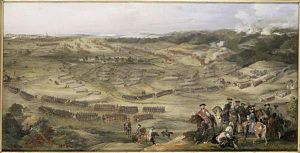Battle of Hastenbeck
| Battle of Hastenbeck | |||||||
|---|---|---|---|---|---|---|---|
| Part of the Seven Years' War | |||||||
 |
|||||||
|
|||||||
| Belligerents | |||||||
|
Hesse-Kassel Brunswick |
|
||||||
| Commanders and leaders | |||||||
|
|
|
||||||
| Strength | |||||||
| 30,000 infantry, 5,000 cavalry, 28 guns |
50,000 infantry, 10,000 cavalry, 68 guns |
||||||
| Casualties and losses | |||||||
| 311 killed, 900 wounded, 200 missing |
614 killed, 676 wounded |
||||||
The Battle of Hastenbeck (26 July 1757) was fought as part of the Invasion of Hanover during the Seven Years' War between the allied forces of Hanover, Hesse-Kassel (or Hesse-Cassel) and Brunswick, and the French. The allies were defeated by the French army near Hamelin in the Electorate of Hanover.
The French, who were allied with Austria, Russia, Sweden and Saxony during the Seven Years' War, invaded Germany in April 1757 with two armies, altogether about 100,000 soldiers. The French hoped to draw the attention of the Kingdom of Prussia, which was allied with Britain and Hanover, away from the Bohemian theatre where Prussia and Austria fought several battles (Lobositz, Prague, Kolin).
One of the two French armies under command of Prince de Soubise marched through central Germany. They joined the Imperial Army, or "Reichsarmee", commanded by Prinz von Hildburghausen. This coalition army later met a Prussian army at the Battle of Rossbach on 5 November 1757 with disaster.
The other French army commanded by Marshal Louis Charles d'Estrées consisted of about 50,000 infantry, 10,000 cavalry and 68 cannons. The army advanced towards the Electorate of Hanover. Prussia was heavily involved with its enemies Austria, Russia and Sweden and therefore was not able to help on the western front. This task was given to the Hanoverian Army of Observation which had little support from Prussia, namely six Prussian battalions. The main part of the "Hanoverian Army of Observation" came from Hanover (about 60%) and Hesse (about 25%), smaller additional forces from Brunswick and Prussia. The total strength of the Hanoverian Army of Observation consisted of about 30,000 infantry, 5,000 cavalry and 28 guns. The army was commanded by William Augustus the Duke of Cumberland who was a son of King George II of Great Britain.
...
Wikipedia
